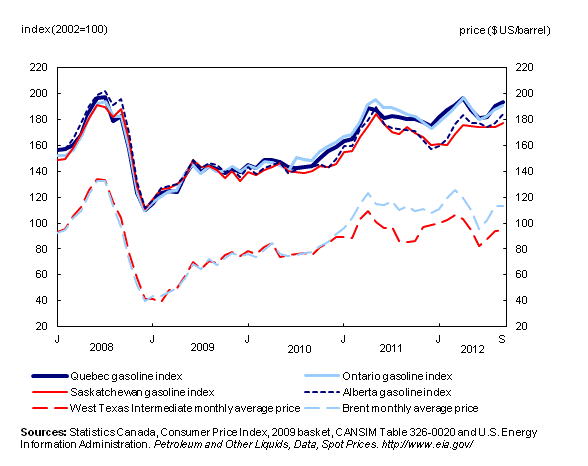Study: Canada's dual crude oil market and the influence on changes in gasoline prices
Archived Content
Information identified as archived is provided for reference, research or recordkeeping purposes. It is not subject to the Government of Canada Web Standards and has not been altered or updated since it was archived. Please "contact us" to request a format other than those available.
Related subjects
-
[an error occurred while processing this directive]
For much of the last decade, gasoline prices have changed at a more or less similar pace across the provinces. A reason for this is that changes in the cost of crude oil have had a similar impact on changes in the price of petroleum products, including gasoline, across the country.
Starting in 2011, rates of change in gasoline prices, as measured by the Consumer Price Index (CPI), have begun to diverge. In general, gasoline prices have increased at a slightly faster pace in the central and eastern provinces than in the west, resulting in a spread between some provincial gasoline indices.
This recent spread in price indexes for gasoline is the largest in 10 years. It is associated with the dual crude oil market in Canada and the recent price differential between crude oil benchmarks.
Divergence between provincial gasoline price indexes coincides with crude oil price differential

Refiners in Western Canada use domestically produced crude oil and, therefore, face prices similar to West Texas Intermediate (WTI), a North American crude oil benchmark.
Refiners in Eastern and Central Canada use either imported crude oil, or a mixture of domestic and imported. As a result, they can encounter crude oil prices that reflect Brent, which is a global crude oil benchmark.
While other factors also determine the final 'pump price' of gasoline, the cost of crude oil is a major contributor. Therefore, changes in crude oil prices generally have a large impact on rates of change in gasoline prices.
Regardless of the source, crude oil prices are set in global and regional markets directed by supply and demand. Canadian refiners are 'price takers,' meaning that the price they pay for crude oil is based on benchmarks.
The price gap between crude oil benchmarks is, in part, related to distribution challenges facing the WTI benchmark. These challenges are linked to the increasing production of crude oil in North America and the fact that many of these oils are 'landlocked.' That is, they must travel by pipeline and thus cannot easily reach global markets.
At the same time, crude oils that can supply global markets and are benchmarked to Brent have been influenced by various upward pressures. These pressures include political instability in various crude oil producing countries, as well as increasing demand for petroleum products in emerging economies, such as India and China.
Consumer spending on gasoline accounts for a relatively large share of total household expenditures. At 5.8%, gasoline has one of the largest 'weights' in the CPI's 2009 basket of goods and services. This means that Canadians spent, on average, 5.8% of their total household budget on gasoline. Therefore, changes in gasoline prices can affect consumer price indices for Canada and the provinces.
Understanding the factors that influence gasoline price movements in Canada, including the dual crude oil market and the emergence of a price differential between crude oil benchmarks, is important in explaining variations in provincial gasoline price indexes and overall consumer price indexes.
Note to readers
This release is based on an article that examines recent movements in gasoline prices across Canada. It examines benchmarks that influence prices in different segments of Canada's crude oil and gasoline refining markets. It also examines the extent to which the recent divergence in crude oil benchmarks coincides with relative changes in gasoline prices across the country.
The study "The influence of crude oil prices on provincial variations in gasoline price changes in the Consumer Price Index (CPI) since 2011" is included in the October 2012 issue of The Consumer Price Index, Vol. 91, no. 10 (Catalogue number62-001-X, free), now available from the Key resource module of our website under Publications.
For more information, or to enquire about the concepts, methods or data quality of this release, contact us (toll-free 1-800-263-1136; infostats@statcan.gc.ca) or Media Relations (613-951-4636; statcan.mediahotline-ligneinfomedias.statcan@canada.ca).
- Date modified:
